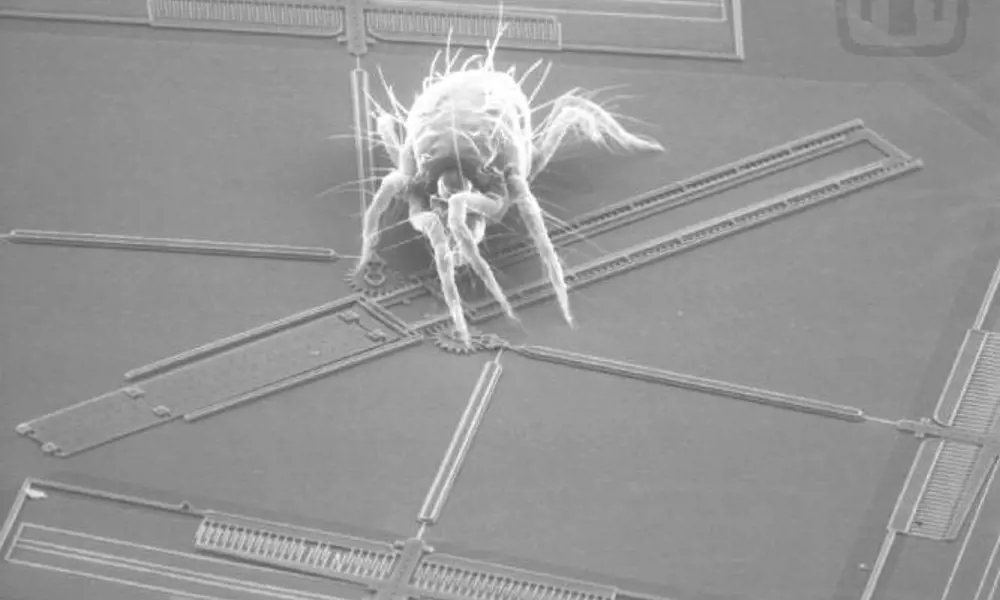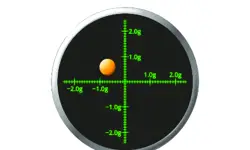
Microelectromechanical systems (MEMS)
Detecting when a vehicle suddenly slows down to initiate airbag deployment was one of the first commercial uses of MEMS. Today, they’re everywhere. Bosch, the market leader, started production in 1998 and has now made over 15 billion.
A typical new car will contain dozens, including MEMS on airbag duty, or monitoring tyre pressure and air conditioning. The accelerometers that detect when your smartphone’s display should rotate from portrait to landscape are MEMS. So are the microphones embedded in AirPods that help separate the wearer’s voice from the background. On board aircraft, MEMS gyroscopes can record aeronautical measurements that once required several kilograms of machinery. Countless other everyday technologies also rely on MEMS, from heart pacemakers to kitchen appliances.
While their functions can differ enormously, what all MEMS have in common is their size and ability to convert electrical signals into movement, or vice versa.
Micro machines
It’s been almost 60 years since the first MEMS were manufactured. Semiconductor engineers capitalised on the manufacturing approaches developed for computer chips and used them to make these microscopic devices.
These days, MEMS are fashioned from silicon, polymers, metals or ceramics. Their internal parts, for example, a spring or weight, can be as small as one micrometre, with overall dimensions ranging from 20 micrometres to a few millimetres. High surface-area-to-volume ratios make them ideally suited to detecting marginal changes in magnetism, pressure, chemical composition, or temperature.
While their functions can differ enormously, what all MEMS have in common is their size and ability to convert electrical signals into movement, or vice versa. A MEMS sensor generates an electrical output when its components register changes in its surroundings, often by bending, stretching or contacting another part. On the other hand, a MEMS actuator converts an electrical input into mechanical movement.
So, what’s actually happening inside? A MEMS sensor might contain a mass suspended between capacitive plates. When the suspended mass tilts towards one plate, it shows up as a change in capacitance. Movement of 0.0001° can be enough to trigger a reading on a tilt sensor. This type of device is known as a capacitive transducer.
Often, the MEMS that come to mind are sensors, from accelerometers, microphones and gyroscopes, to devices detecting pressure and flow. However, MEMS can also work as switches and oscillators – for instance in communication systems. Meanwhile, micronozzles are common in inkjet printers.
Built to last
While impressive in their own right, MEMS do not work in isolation. They must be bridged somehow with the outside world, typically by integration into electronic circuitry on a microchip. This also enables functions such as signal filtering or amplification.
MEMS – particularly sensors – often need some degree of access to their external environments. Yet they must also be packaged to protect them from contamination, for instance from dust, and some MEMS have to be hermetically sealed. Packaging also dissipates heat and offers their sensitive components protection from mechanical shocks and other unwanted physical stresses.
All of this is key when you consider the conditions MEMS often operate under: extreme temperatures, protective systems in vehicles crashing at high speeds, and being fired into space are just a few examples.
While impressive in their own right, MEMS do not work in isolation. They must be bridged somehow with the outside world, typically by integration into electronic circuitry on a microchip.
Where next for MEMS? The trend for even smaller wearable devices is likely to continue with them shrinking even further. Aided by MEMS, miniaturised hearing aids, precision drug delivery and noninvasive medical diagnostics could all be part of this future. Meanwhile, increasingly ‘smart’ autonomous vehicles will be kitted out with even more MEMS than cars today.
***
This article originally appeared in Ingenia 94 (March 2023).
Keep up-to-date with Ingenia for free
SubscribeRelated content
Electricals & electronics

Accelerometers
Used in earthquake measurements, laptops, planes and even in stargazing apps, today’s accelerometers are much smaller than when they were first developed in 1927. Find out how they detect movement and vibration.

How to maximise loudspeaker quality
Ingenia asked Dr Jack Oclee-Brown, Head of Acoustics at KEF Audio, to outline the considerations that audio engineers need to make when developing high-quality speakers.

Cable fault locator
The winner of the Institute of Engineering and Technology’s 2014 Innovation Award was EA Technology’s CableSnifferTM, which uses a probe and chemical sensing technology to identify faults, saving energy companies millions of pounds each year.

High speed evolution
In December 2010, Eurostar International Ltd awarded a contract for 10 new high speed trains to Siemens. The company has used a system developed over decades to maximise the performance and passenger-carrying ability of its 320km/h trains.
Other content from Ingenia
Quick read

- Environment & sustainability
- Opinion
A young engineer’s perspective on the good, the bad and the ugly of COP27

- Environment & sustainability
- Issue 95
How do we pay for net zero technologies?
Quick read

- Transport
- Mechanical
- How I got here
Electrifying trains and STEMAZING outreach

- Civil & structural
- Environment & sustainability
- Issue 95